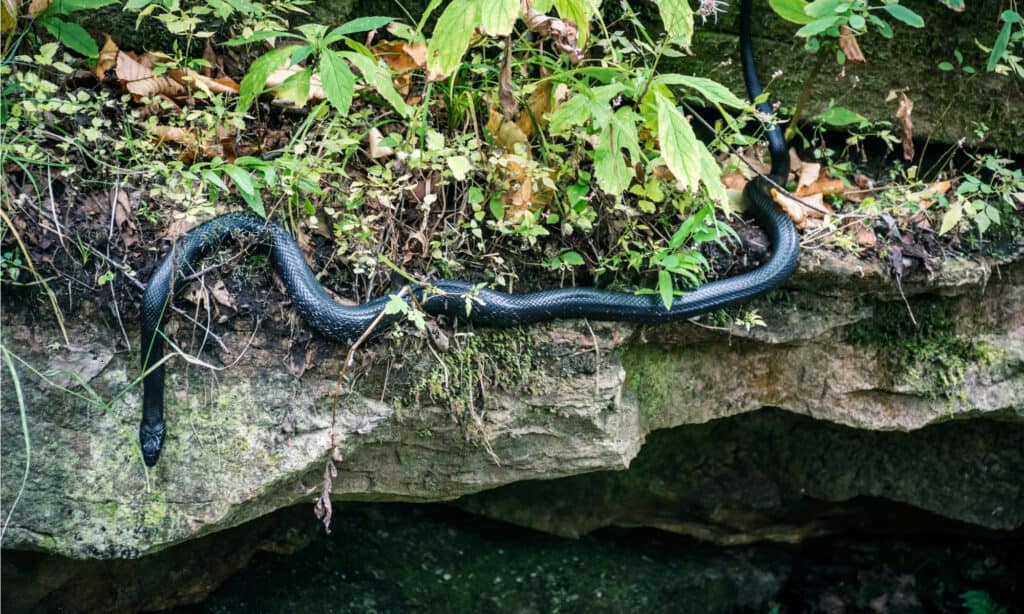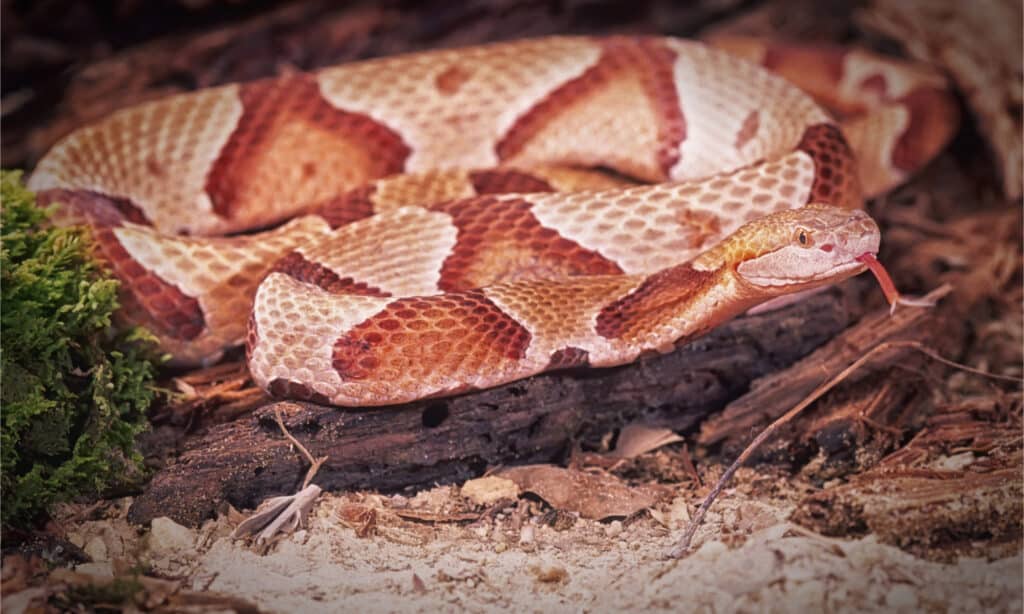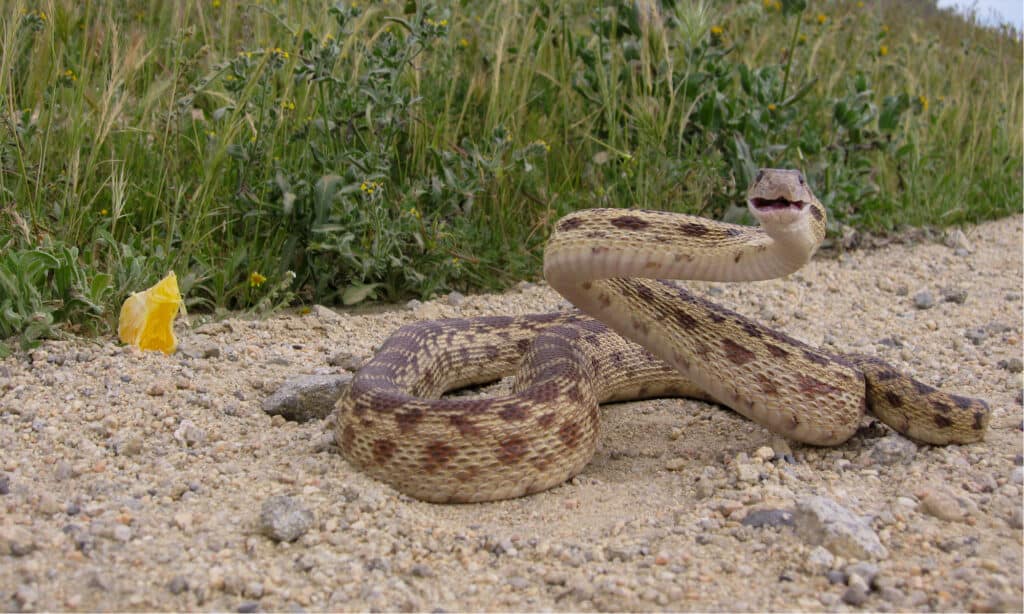There are almost 4,000 types of snakes on Earth, and despite what most people think, very few are dangerous. Snakes are helpful because they eat rats and mice that do not belong around the house. These are the same rodents that transmit Lyme disease through ticks.
Moreover, snakes are an essential part of the food chain because they feast on pests like grasshoppers that are difficult to catch, thanks to their ambush hunting strategies. If you have ever seen a bunch of grasshoppers destroying a field of growing plants, you definitely understand how helpful a snake can be!
That’s why you should learn what snakes to be afraid of, as most will rather help you around the house than harm you! Below are the common snakes that eat mice and other pesky rodents.
Black Rat Snake

The non-venomous black rat snake has a long, black body and a white belly.
©Andrew F. Kazmierski/Shutterstock.com
The non-venomous black rat snake has a long, black body and a white belly. If you are looking for one, the mountains and shoreline of Chesapeake Bay are the best places to look. Originally, the black rat snake came from Ohio, South Carolina, and Kentucky. Black rat snakelets are light gray with black patches running along their backs.
People often call this snake a “pilot snake” because of the false belief that it leads poisonous snakes to warm places to sleep in the winter.
What Are the Predators of a Black Rat Snake?
Foxes, owls, and hawks are the main predators of black rat snakes. To ward off predators, it coils its body and makes a rattlesnake-like noise with its tail while moving through dead leaves. To keep predators away from eating them, they may also produce a foul-smelling substance when picked up or handled. Black rat snakes are reported to be one of the most aggressive rat snake species.
What Does a Black Rat Snake Eat?
Small rodents, including mice, rats, moles, and chipmunks, are the main food sources for black rat snakes. They have also been observed eating frogs, lizards, and bird eggs.
They kill their prey by constriction, which is when the snake wraps its body around the victim and holds on until the victim’s heart stops. The prey is swallowed whole and slowly digested over several days.
Northern Copperhead Snake

The northern copperhead snake has reddish or brown crossbands that are wide on the sides and narrow in the center.
©outdoorsman/Shutterstock.com
The body of this stunning, copper-colored, two-toned snake is covered in striking hourglass patterns.
The northern copperhead snake has reddish or brown crossbands that are wide on the sides and narrow in the center. The scales are keeled, and the belly is pinkish with darker markings. The spade-shaped or triangular head of this venomous snake is a defining feature.
Another distinguishing feature is a “pit” between the eyes and nostrils on each side of the head. Typically, copperheads are between 24 and 37 inches long. Young copperheads have bright yellow tail tips, making them easy to spot.
How Do Copperheads Multiply?
Copperheads spend the remainder of the year in dens and are active from April to October. Other snakes frequently coexist in these dens. Copperheads will start looking for partners soon after leaving their dens. This species reaches maturity by the time it’s three or four years old.
Because it is ovoviviparous, the eggs remain inside the mother until they hatch. Females can typically produce 2 – 10 snakelets. Because adults do not care for their young after birth, they are left to fend for themselves.
Where Do Copperheads Live, and What Do They Eat?
Copperheads prefer steep terrain over low-lying locations. They are mainly found at the borders of meadows, on talus slopes, on rocky hillsides, and along basalt ridges. Swamps, streams, and marshes frequently surround the fields. Dens are generally found in deep, moist, wooded environments close to wetlands.
When waiting for their victim, copperheads lay still in leaf litter. They primarily eat mice and other small rodents, although they can also eat insects, small birds, and other reptiles and amphibians.
Gopher Snake

Gopher snakes are typically solitary.
©rawaccess/Shutterstock.com
The six subspecies of the gopher snake are mostly found in western North America, southern Canada, and northern Mexico. They are carnivores that thrive in arid environments below 2,000 feet in elevation. Even though they aren’t venomous, their bites are painful to their prey and help the snakes immobilize small animals like birds and gophers. This snake can grow up to 9 feet long and is mainly calm.
What Are the Behavioral Characteristics of a Gopher Snake?
Gopher snakes are typically solitary. They have home territories, according to a study conducted in 2003 in Copeia. Although they are small (less than a quarter of a mile), the snakes stick with them for many years.
Even though gopher snakes are mostly active during the day, you can sometimes see them moving and hunting at night. They are skilled burrowers and climbers.
Coyotes, foxes, and red-tailed hawks are the most frequent gopher snake predators. Sometimes, larger king snakes would consume them as well. Gopher snakes often camouflage with their surroundings. As a result, people frequently step on them. When threatened, they will hiss loudly, flatten their heads, and vibrate their tails.
The Washington State Department of Natural Resources says that gopher snakes often lie in the sun on roads, which puts them at risk of getting hit by cars. On the highway, they enjoy taking up the entire space. Instead of slithering off the road to safety when threatened, they will coil up and take an aggressive position.
What Do Gopher Snakes Eat?
The gopher snake is considered a farmer’s best buddy. Gopher snakes prey on small rodents, which can ruin crops due to their tendency to dig. They also eat small birds and even bats. These snakes are the ideal deterrent for rodents attracted to animal feed, fertilizers, and garden crops in sheds, barns, and greenhouses.
Up Next:
- Discover 5 Snakes that Eat Fish: Pescatarian Snakes?
- 9 Snakes That Eat Other Snakes (Even Rattlesnakes!)
- 4 Snakes That Eat Birds: Not The Other Way Around!
The photo featured at the top of this post is © ButtermilkgirlVirginia/Shutterstock.com
Discover the "Monster" Snake 5X Bigger than an Anaconda
Every day A-Z Animals sends out some of the most incredible facts in the world from our free newsletter. Want to discover the 10 most beautiful snakes in the world, a "snake island" where you're never more than 3 feet from danger, or a "monster" snake 5X larger than an anaconda? Then sign up right now and you'll start receiving our daily newsletter absolutely free.
Thank you for reading! Have some feedback for us? Contact the AZ Animals editorial team.






